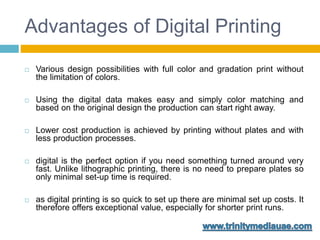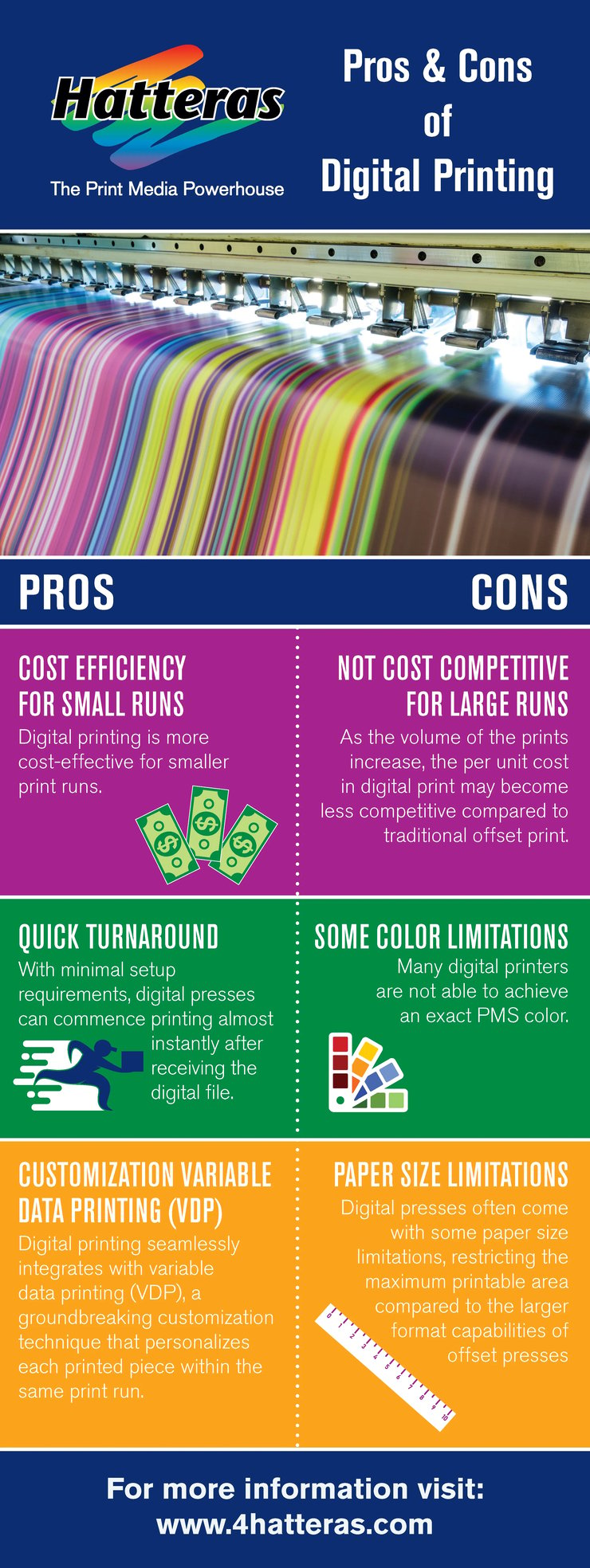The Definitive Guide for Digital Printing
The Definitive Guide for Digital Printing
Blog Article
Facts About Digital Printing Revealed
Table of ContentsDigital Printing - The FactsDigital Printing Fundamentals ExplainedIndicators on Digital Printing You Should KnowExcitement About Digital PrintingAn Unbiased View of Digital Printing10 Simple Techniques For Digital Printing
Variable information printing, such as straight mail with personalized codes and addresses, is preferably suited for digital printing. Digital fast printing only requires 4 steps of design, testimonial, printing and binding to get whatever done. Digital quick printing has an unrivaled benefit: print on demand.According to PMMI, digital printing enables brand names and producers to react rapidly to consumer needs while enhancing the supply chain, decreasing warehousing expense and waste, and delighting in faster time to market. That all sounds great, but how does this technology do all that? The significant differentiator of these technologies is that there are no set up fees and no plates with electronic printing.
The Definitive Guide for Digital Printing
According to Wikipedia, the biggest difference between electronic printing and standard techniques such as lithography, flexography, gravure, or letterpress - Digital Printing is that there is no need to replace printing plates in electronic printing, whereas in these analog printing techniques the plates are consistently changed. This results in quicker turn-around time and decreases price when making use of electronic printing.
Digital printing is very adaptable, so it's very easy to make modifications to the bundle layout rapidly. It all goes back to the plates.
With standard printing methods, short-run printing is simply not possible. Because a wonderful layout can make or damage your product, electronic printing consistently produces top notch, clear and colorful graphics each time.
Digital printing is the procedure of printing digital-based pictures directly onto a range of media substratums. There is no requirement for a printing plate, unlike with countered printing. Digital data such as PDFs or desktop computer publishing documents can be sent straight to the digital printing press to publish on paper, photo paper, canvas, material, synthetics, cardstock and other substrates.
A Biased View of Digital Printing
According to PMMI, electronic printing permits brands and makers to respond promptly to customer demands while improving the supply chain, lowering warehousing expense and waste, and taking pleasure in faster time to market. That all sounds great, yet exactly how does this modern technology do all that? The significant differentiator of these innovations is that there are no set-up charges and no plates with digital printing.
This results in quicker turnaround time and decreases price when utilizing digital printing.

The Facts About Digital Printing Uncovered
Much more supply can imply more waste down the road. With traditional printing techniques, short-run printing is just not Get More Information possible. Due to the fact that a wonderful style can make or break your item, digital printing constantly produces top notch, clear and vivid graphics each time. Digital printing on adaptable bags includes the brilliant, vibrant, and exact graphics that almost bid customers to get to out and touch them.

According to PMMI, electronic printing permits brands and suppliers to react promptly to client demands while enhancing the supply chain, reducing warehousing cost and waste, and taking pleasure in faster time to market. That all sounds fantastic, however exactly how does this technology do all that? The major differentiator of these innovations is that there are no set-up costs and no plates with electronic printing.
The Only Guide for Digital Printing
According to Wikipedia, the biggest distinction between digital printing and typical approaches such as lithography, flexography, gravure, or letterpress is that there is no demand to change printing plates in digital printing, whereas in these analog printing techniques the plates are repeatedly changed. This leads to quicker turn-around time and reduces cost when utilizing electronic printing.
Rapid manufacturing indicates obtaining your product to market much faster. It also suggests it's less complicated and faster to make changes in the future, when you transform a dish, include a SKU, or produce seasonal product packaging. Digital printing is highly versatile, so it's easy to make changes to the package layout quickly. All of it returns to home plates.

The Digital Printing Ideas
Digital printing is the process of printing digital-based images directly onto a range of media substratums. There is Get More Information no requirement for a printing plate, unlike with offset printing. Digital files such as PDFs or desktop publishing files can be sent straight to the electronic printing machine to print theoretically, picture paper, canvas, material, synthetics, cardstock and various other substratums.
Report this page